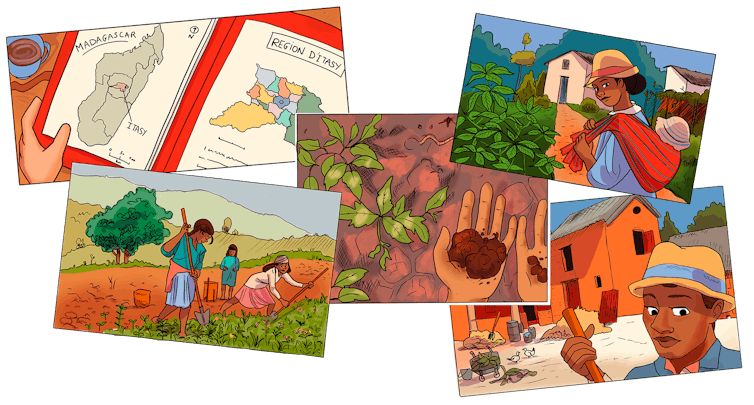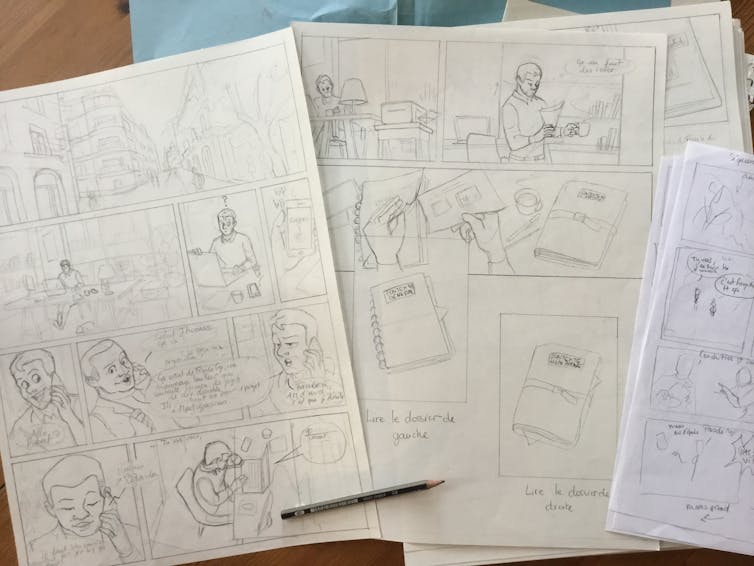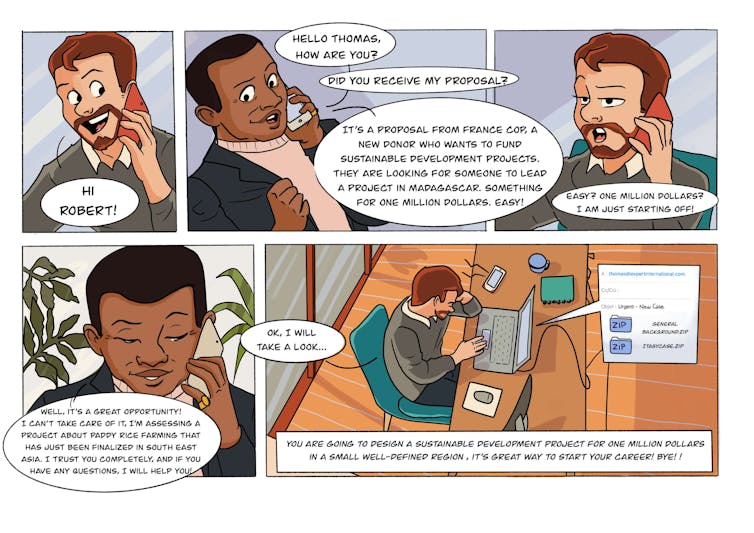
More often than not, climate change will carry associations of “Apocalypse fatigue” and daunting technical and scientific jargon. We are therefore particularly pleased to announce the publication of A Million-Dollar Question, an entertaining and interactive comic book on the climate challenges – and solutions! – facing agriculture, available in full on the website of illustrator Caroline Gaujour
Over the past years global heating has particularly affected agriculture, from soil degradation to declining crop yields. At the same time, the sector stands at once as a victim and perpetrator, with food systems accounting for one third of global emissions, according to recent research.
But there is hope. Although less publicised than forest conservation policies, soil use methods offer opportunities to fight climate change.
Among them is the use of carbon-enriched soil. Several international projects – from the French-led 4 per 1,000 initiative aiming to increase the level of carbon stored by soils by 4% every year to the Great Green Wall in the Sahel region – are contributing to this goal.

It is now more than ever crucial to develop sustainable agriculture, which profits farmers without harming the environment. In the Global South, such projects are already under way – often with the backing of NGOs. The end goal is both to boost agricultural productivity and profit, while slashing greenhouse gas emissions.
As academics at the French National Research Institute for Sustainable Development (IRD), we wanted to tell people about our collaboration in this area with a team from the University of Antananarivo (Madagascar), and to pique their curiosity about various rural development professions.
Carbon-busting farming in Madagascar
We wanted to showcase situations and characters that readers could identify with, thereby providing a medium for discussion about future interventions and training.
The comic book was initially inspired by our scientific paper with Narindra Harisoa Rakotovao, a young Malagasy scientist examining the carbon-absorbing properties of agroecological holdings in the Itasy region in the centre of the island.
To make the issue more tangible to the lay person, we then decided to turn it into an interactive story where we follow the adventures of a young international consultant named Thomas.
Illustrator Caroline Gaujour began by adapting our interactive scenario to storyboards, with the help of reference photos from the field. She then outlined the different characters, before turning her attention to 35 pages of drawings.


The comic book starts with a description of the issues surrounding a rural development program in a small, 4,400-acre farming area near Itasy. A farmer, a volunteer, a senior international expert and a researcher take turns to pitch farming projects to Thomas, who, with the help of the reader, must decide which one is best suited to the region.
Projected over a 20-year period, three indicators are used to measure the potential benefits of each project: the greenhouse gas (GHG) emissions balance, the potential economic benefits to farmers, and the effectiveness of economic investments in mitigating GHG emissions. The outcome of each project is explained separately.

The pursuit of farming’s Holy Grail
Throughout the comic book, the reader follows the thought processes of the young consultant, who works for a donor.
Donor-backed farming projects are often large-scale and costly. The scope and impact on populations can be significant. How, and with whom, should such projects be defined? What objectives should be set? How can the donors’ money be best put to use? Who should decide? These are all questions the young consultant must ask himself.
Over the course of his encounters, the sheer amount of information and points of view further hamper his decision-making.


A researcher wants to shake the young consultant out of his torpor, but she overwhelms him with even more information. Research is treated here with humour: it brings no solutions, uncovers nothing, or very little, but raises a lot of questions!
The flurry of issues illustrate the vital importance of research on these topics. There are no obvious solutions, but no bad choices either – except to sit back and do nothing.

The “SoCa” research project, which includes this publication, was supported by the BNP Paribas Foundation, as part of the Climate and Biodiversity Initiative. Discover the full comic book “A Million-Dollar Question” here.
Translated from the French by Jemma Dunnill for Fast ForWord
Tiphaine Chevallier a reçu des financements de la Fondation BNP Paribas.
Lydie Chapuis-Lardy received funds from the Climate Initiative of the Fondation BNP Paribas
This article was originally published on The Conversation. Read the original article.







